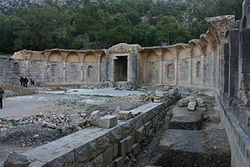Zaghouan Governorate
| زغوان Zaghouan
|
|
|---|---|
| Basic data | |
| Country | Tunisia |
| Capital | Zaghouan |
| surface | 2820 km² |
| Residents | 177,000 (2014) |
| density | 63 inhabitants per km² |
| ISO 3166-2 | TN-22 |
Coordinates: 36 ° 24 ' N , 10 ° 9' E
The Zaghouan Governorate ( Arabic ولاية زغوان, DMG Wilāyat Zaġwān ) is one of the 24 governorates in Tunisia . It is located in the northeast of the country at altitudes between 150 and 1300 m above sea level. d. M., has an area of 2820 km² (approx. 1.7% of the land area) and about 177,000 inhabitants (as of 2014). The capital is the city of Zaghouan .
Delegations

The governorate has six delegations :
| delegation | 2004 residents |
Residents 2014 |
|---|---|---|
| Bir Mcherga | 21,508 | 24,387 |
| El Fahs | 43,678 | 46,449 |
| Nadhour | 28,550 | 30,366 |
| Saouaf | 12,095 | 12,681 |
| Zaghouan | 34,367 | 38,445 |
| Zriba | 20,765 | 24,617 |
| total | 160.963 | 176.945 |
climate
The average temperatures are - depending on the altitude and the cloud cover - between 2 and 12 ° C in winter nights and between 5 and 15 ° C during the day; the summer temperatures are mostly in the range between 25 and 40 ° C during the day and between 10 and 3 ° C at night. The annual amount of precipitation usually varies between 400 and 500 millimeters.
economy
Agriculture is still the dominant economic sector in the region - cereals, fruit growing (olives, almonds) and the cultivation of vegetables (asparagus, tomatoes etc.) are the main products; in addition, cattle breeding (milk, meat) is not insignificant.
nature
The region is largely man-made; Larger forest areas are only in the nature reserve around the Djebel Zaghouan (1295 m).
history

The area was already settled in the time of the late megalithic cultures (around 2500 BC); later the Berbers settled here , who were subjugated by the Romans . In the 6th century, the Byzantines controlled the area with their fortifications. Since the second half of the 7th century, Islam has dominated religious and spiritual life.
Culture
The most important Roman town in the governorate was Zaghouan ( Ziqua ) itself, but the archaeological site of Thuburbo Majus is also important; the remains of the fortresses from the Byzantine era are mostly in very poor condition.


